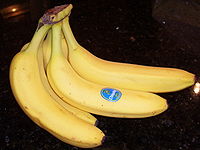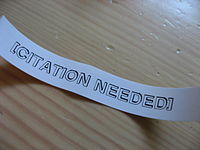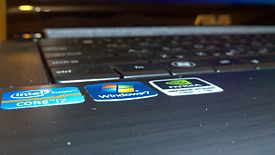- Label
-
For other uses, see Label (disambiguation).
 Shirt with labels
Shirt with labels A bundle of bananas with a label
A bundle of bananas with a label
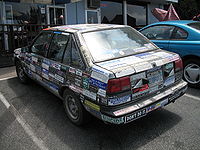 Bumper stickers on a car.
Bumper stickers on a car.
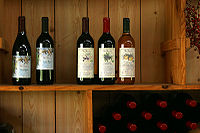 Bottles of wine with labels
Bottles of wine with labels
A label is a piece of paper, polymer, cloth, metal, or other material affixed to a container or article, on which is printed a legend, information concerning the product, addresses, etc. A label may also be printed directly on the container or article.
Labels have many uses: product identification, name tags, advertising, warnings, and other communication. Special types of labels called digital labels (printed through a digital printing) can also have special constructions such as RFID tags, security printing, and sandwich process labels.
Contents
Attachment
Labels can be attached by:
- Heat activated adhesives: for example, "in-mold labeling" can be part of blow molding containers and employs heat activated adhesives. Hot melt adhesives are also used.
- Pressure sensitive adhesives (also called PSA or self-stick) are applied with light pressure without activation or heat. PSA labels often have release liners which protect the adhesive and assist label handling.
- Rivets used to attach information plates to industrial equipment
- Shrink wrap for printed shrinkable labels placed over packages and then heated to shrink them
- Sewing for clothing, tents, mattresses, industrial sacks, etc.
- Wet glue (starch, dextrin, PVA [disambiguation needed
 ], etc.) or water moistenable gummed adhesive
], etc.) or water moistenable gummed adhesive - Yarn or twine, so as to tie on the label
PSA Adhesive types
Pressure sensitive label adhesives are commonly made from water based acrylic adhesives, with a smaller volume made using solvent based adhesives and hotmelt adhesives. The most common adhesive types are:
- Permanent – Typically not designed to be removed without tearing the stock, damaging the surface, or using solvents. The adhesion strength and speed can also be varied. For example, full adhesion can be nearly instant, or the label can be almost removable for a short period with full adhesion developing in minutes or hours (known as respositionable adhesives).
- Peelable – Adhesion is fairly strong and will not fall off in normal circumstances, but the label can be removed relatively easily without tearing the base stock or leaving adhesive behind on the old surface. The adhesive is usually strong enough to be applied again elsewhere. This type is frequently known as 'removable'. There are many different types of removable adhesives, some are almost permanent, some are almost 'ultra peelable'.
- Ultra-peelable – Designed principally for use on book covers and glass, when removed these adhesives labels do not leave any residue whatsoever. Adhesion is weak and only suitable for light duty applications. Normally these labels have very little adhesion to anything once they've been removed.
- Freezer or Frost fix – Most permanent and peelable adhesives have a service temperature limit of -10 degrees Celsius, whereas freezer (otherwise known as frost fix) adhesives have a service temperature -40 degrees Celsius and are suitable for deep freeze use.
- High Tack – A type of permanent adhesive that exhibits a high initial grab to the application surfaces, and is commonly used at higher coat weights to enable labels to adhere strongly to difficult, rough or dirty surfaces.
- Static Cling – This is not actually an adhesive at all. The material (usually PVA) has a static charge to enable its adhesion to flat, smooth surfaces such as glass. It is not sticky as such and is commonly used for window advertising, window decorations, oil change labels, etc.
Stock types
The "label stock" is the carrier which is commonly coated on one side with adhesive and usually printed on the other side. Label stocks can be a wide variety of papers, films, fabric, foils, etc.
- Litho – one of the most common base stocks
- Latex – a litho stock with some added latex allows the label to be much more flexible and form around certain curved objects more easily than standard litho.
- Various plastics such as acetate, vinyl, and PET film allow a variety of features, such as greater strength, flexibility [disambiguation needed
 ], transparency, resistance to tearing, etc. They typically require special equipment and printing methods (ultra-violet curing is common) as they do not normally print well with conventional ink. A bumper sticker is usually a vinyl label with a very strong, durable adhesive and lightfast inks. Embossing tape is "printed" by pressing raised elements similar to printing type onto it, which produces raised glyphs that look white due to discoloration of the plastic. A type known as 'Destructible Vinyl' is commonly used for asset labels. It combines a very thin frangible face stock with a very strong high tack adhesive, thus making the label impossible to remove without damaging it. Engraved multi-layer Traffolyte labels are frequently used in industrial situations due to their durability.
], transparency, resistance to tearing, etc. They typically require special equipment and printing methods (ultra-violet curing is common) as they do not normally print well with conventional ink. A bumper sticker is usually a vinyl label with a very strong, durable adhesive and lightfast inks. Embossing tape is "printed" by pressing raised elements similar to printing type onto it, which produces raised glyphs that look white due to discoloration of the plastic. A type known as 'Destructible Vinyl' is commonly used for asset labels. It combines a very thin frangible face stock with a very strong high tack adhesive, thus making the label impossible to remove without damaging it. Engraved multi-layer Traffolyte labels are frequently used in industrial situations due to their durability. - Foil – has the shiny properties of a metal foil.
- Thermal – direct thermal label stock will change color (usually black) when heated. A heating element in the shape of letters or images can be used to create an image on the label. Custom labels can be easily be made on location in this way. A disadvantage is durability, because another heat source can ruin or obscure the image, or it may fade completely over time.
- Thermal Transfer for applications that cannot use Thermal (Thermal Direct) label material because of heat source proximity or short label life, a more widely used material is Thermal Transfer Label printer. This material has the advantage of a much longer readable life and does not fade with time or heat. Most major manufacturers of Thermal Printers can be used for either Thermal Transfer (TT) or Thermal (DT) labels. A thermal transfer ribbon will be required to print the labels. The cost of the ribbons + TT labels is similar to that of the DT labels on their own.
- None – labels can be printed directly on adhesive without using a substrate. Labels made in this manner are extremely fragile, however, and have been rendered virtually obsolete by other printing methods such as silk screen.
- Thermal Transfer Ribbon Types
- Wax is the most popular with some smudge resistance, and is suitable for matte and semi-gloss paper labels.
- Wax / Resin is smudge resistant, suitable for semi-gloss paper and some synthetic labels.
- Resin is scratch and chemical resistant, suitable for coated synthetic labels.
The stock type will affect the types of ink that will print well on them.
Corona treating or flame treating some plastics makes them more receptive to inks and adhesives by reducing surface tension.
Application and use
Labels can be supplied:
- separately
- on a roll
- on a sheet
Many labels are pre-printed by the manufacturer. Other have printing applied manually or automatically at the time of application.
Some labels have protective overcoats, laminates, or tape to cover them after the final print is applied. This is sometimes before application and sometimes after.
Labels are often difficult to peel and apply. Most companies use a Label dispenser to speed up this task.
Specialized high speed application equipment is available for certain uses.
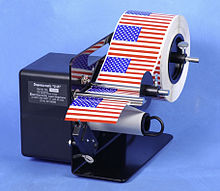 A typical Label dispenser
A typical Label dispenser
Color
Ink and base stock color choices commonly conform to the Pantone Matching System (PMS) colors. The Pantone system is very dominant in the label printing industry. Additionally specialty inks such as metallic, UV ink, magnetic ink, and more are available. Ink is usually transparent however it can be made opaque. It has been known for certain companies to patent "their own" color. [1]. Digital labels use process colors to replicate Pantone solid colors.
Specialized labels
- Piggyback labels are made from combining two layers of adhesive substrate [2]. The bottom layer forms the backing for the top. The label can be applied to any object as normal, the top layer can be a removable label that can be applied elsewhere, which may change the message or marking on the remaining label underneath. Often used on Express mail envelopes.Other applications include price change labels where when being scanned at the till the till assistant can peel back the price-reduction label and scan the original barcode enabling stock flow management. Also, as the retained label is adhesive free it prevents customers from re-applying the cheaper priced labels to premium products. you can view an example of this [3]
- Smart labels have RFID chips embedded under the label stock.
- Asset Labels / Tags are used for marking fixed and non-fixed assets. They are usually tamper-evident, permanent or frangible and usually contain a barcode for electronic identification using readers.
- Blockout labels are not see-through at all, concealing what lies underneath with a strong gray adhesive.
- Radioactive labels The use of radioactive isotopes of chemical elements, such as carbon-14, to allow the in vivo tracking of chemical compounds.
- Laser Labels are generally die cut on 8.5" x 11" sheets(US letter) and a4 size, and come in many different shapes, sizes [4][5], and materials. Laser label material is a nonporous stock made to withstand the intense heat of laser printers and copiers. A drawback of laser labels is that the entire sheet needs to be printed before any labels are used; once labels have been removed the sheet cannot be put through the printer again without damaging the printing mechanism.
- Inkjet Labels are generally die cut on 8.5" x 11" sheets (US letter) and a4 size, and come in many different shapes, sizes, and materials. Inkjet label material is a porous stock made to accept ink and dye from your inkjet printer. One of the more modern inkjet label material stocks is waterproof printable inkjet material commonly used for soap or shower gel containers.
- Security Labels are used for anti-counterfeiting, brand protection, tamper-evident seals, anti-pilferage seals, etc. These combine a number of overt and covert features to make reproduction difficult. The use of security printing, holography, embossing, barcodes, RFID chips, custom printing, weak (or weakened) backings, etc. is common. They are used for authentication, theft reduction, and protection against counterfeit and are commonly used on ID cards, credit cards, packaging, and products from CDs to electronics to clothing.
- AntiMicrobial Labels With the growth in hospital acquired infections such as MRSA and E-Coli the use of Antimicrobial labels in infection sensitive areas of hospitals are helping in combating these types of microbes.
Uses
Stickers
Main article: StickerProduct label
Permanent product identification by a label is common. These labels need to be able to bond securely to the surface for its intended life and under in-use conditions. For example a label on an automobile engine needs to be resistant to the heat and oils encountered and to be secure for many years of use.
Removable product labels need to hold until they must be removed. For example, a label on a new refrigerator has installation and usage information: the label needs to be able to be removed cleanly and easily from the unit once installed.
An eco-label is used on consumer products (including foods) to identify products that may be less damaging to the environment and/or to humankind than other related products.
Asset labeling
In industrial environments, asset labeling is used to clearly identify assets for maintenance and operational purposes. Such labels are frequently made of engraved Traffolyte or a similar material.
Textile labeling
See also: Laundry symbolIn certain clothing articles, a label or other affixed instructions that report how a product should be refurbished. This type of label is required by the FTC, Federal Trade Commission, for certain clothing items in the United States of America.[1]
A label including a tax identification number and material content list may also be required for certain textile items.[2]
The common textile labels used on garments can be classified into four main groups – Woven labels, Leather labels, PVC/Plastic Labels, and Embroidered Labels. It is one of the primary tools used to establish brand identity.[3]
Package label
Packaging often has labels attached to (or integral with) the package. These communicate pricing, barcodes, UPC identification, usage guidance, addresses, advertising, recipes,[4] and so on. They also may be used to help resist or indicate tampering or pilferage. Often high speed label printer applicators are used to apply labels to packages.
Mailing label
Letters and packages need labels to identify the addressee and the sender. Many software packages such as word processor and contact manager programs produce standardized mailing labels from a data set that comply with postal standards. These labels may also include routing barcodes and special handling requirements to expedite delivery.
Environmental considerations
Labels can aid in recycling and reuse by communicating the material content of the item, instructions for disassembly, recycling directions, etc.
Based on the solid waste hierarchy, the quantity and size of labels should be minimized without reducing necessary functionality. Material content of a label should comply with applicable regulations. Life cycle assessments of the item being labeled and of the label itself are useful to identify and improve possible environmental effects. For example, reuse or recycling are sometimes aided by a label being removable from a surface. If a label remains on an item during recycling, a label should be chosen which does not hinder the recyclability of the item.[5][6]
Notes
- ^ Clothes Captioning: Complying with the Care Labeling Rule
- ^ Threading Your Way Through the Labeling Requirements Under the Textile and Wool Acts
- ^ Garment Labels 101 – CF Accessories.com
- ^ http://www.specialtyprinting.net/supermarket-and-retail/merchandising/
- ^ Kovach, A; Brown, S (July 1, 2008), "Label recycling: a materials issue", Packaging Digest, http://www.packagingdigest.com/
- ^ Katz, S (July 2008), "Waste Recycling", Label and Narrow Web, http://www.labelandnarrowweb.com/articles/2008/07/waste-recycling
See also
References
- ASTM D5375 Standard Test Methods for Liner removal at High Speeds from Pressure-Sensitive Label Stock
- ASTM D6252 Standard Test Method fr Peel Adhesion of Pressure Sensitive Label Stocks at 90 deg Angle
- ASTM D7298-06 Standard Test Method for Measurement of Comparative Legibility by Means of Polarizing Filter Instrumentation
- Brody, A. L., and Marsh, K, S., "Encyclopedia of Packaging Technology", John Wiley & Sons, 1997, ISBN 0-471-06397-5
Labeling Label Construction Adhesive · Die cutting (web) · Hologram · In-mould labelling · Paper · Perforation · Pressure sensitive adhesive · Plastic · Printing · Release liner · Security printing · Smart label · Sticker ·Content Advertising · Barcode · Cigarette warning label · Ecolabel · Food labeling regulations · Mandatory labelling · Nameplate · Nutrition facts label · Radio frequency identification · United Kingdom food labeling regulations · UPC · Warning label · Wine labelUse Categories:- Stationery
- Packaging materials
Wikimedia Foundation. 2010.

